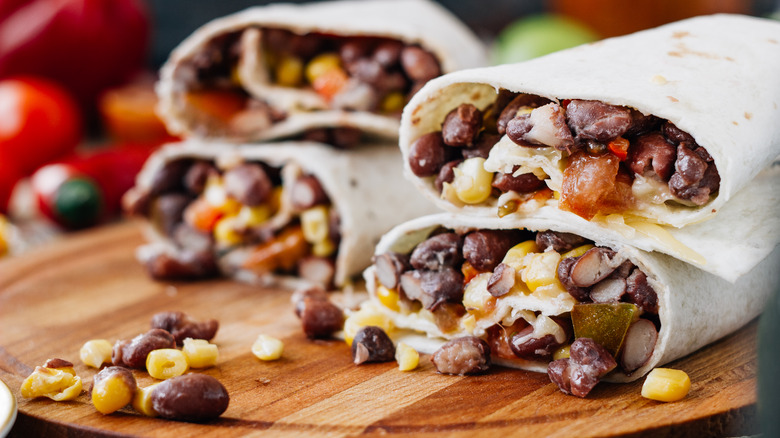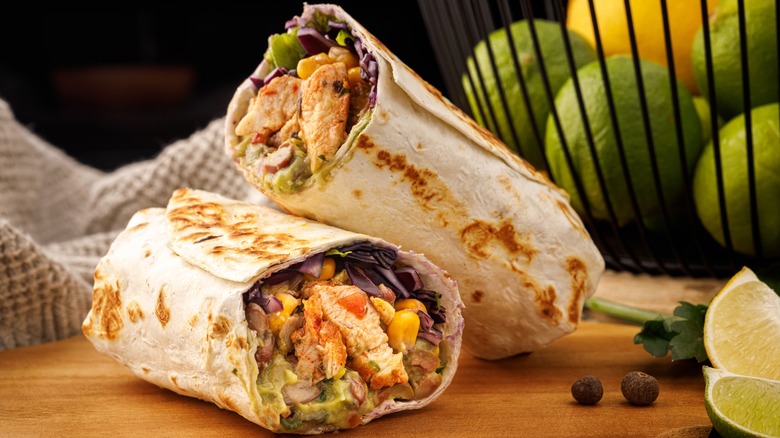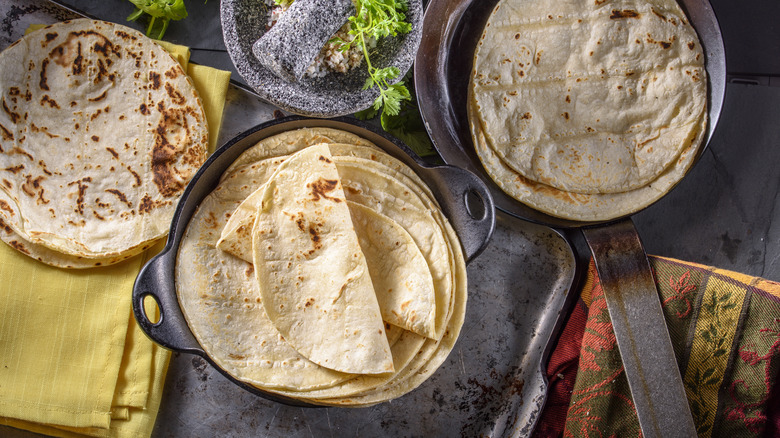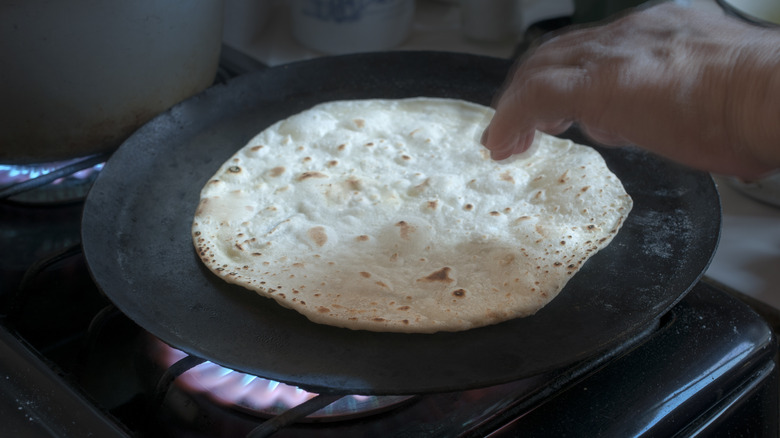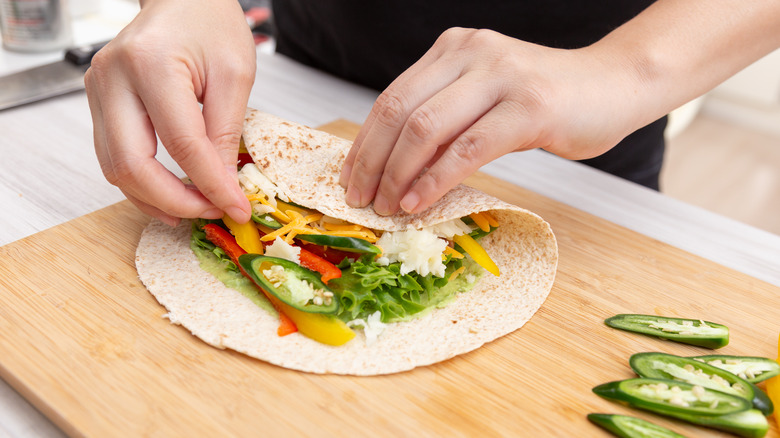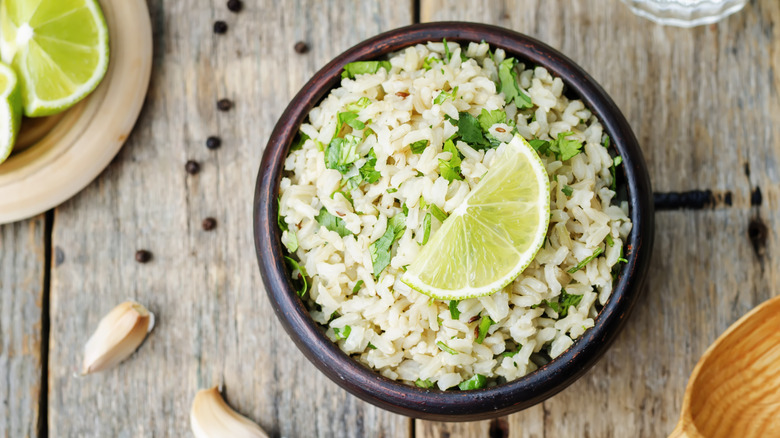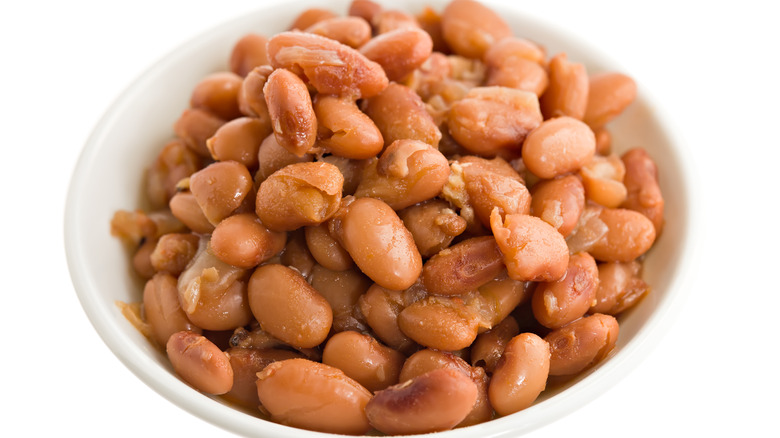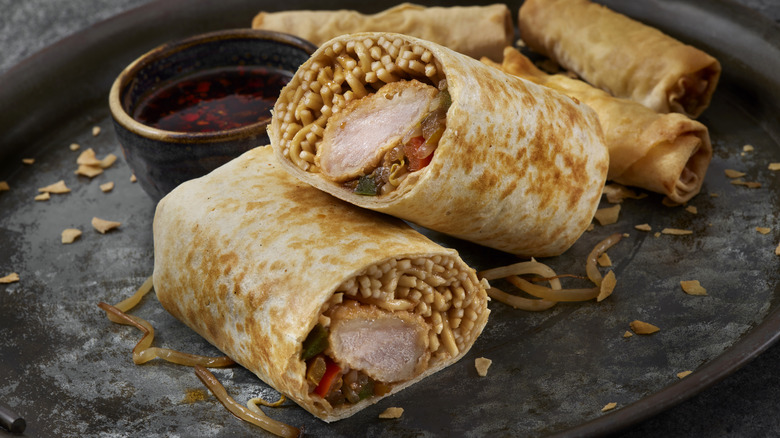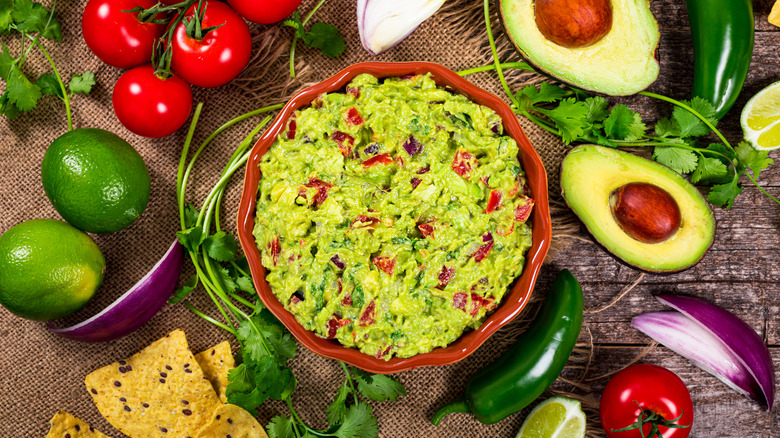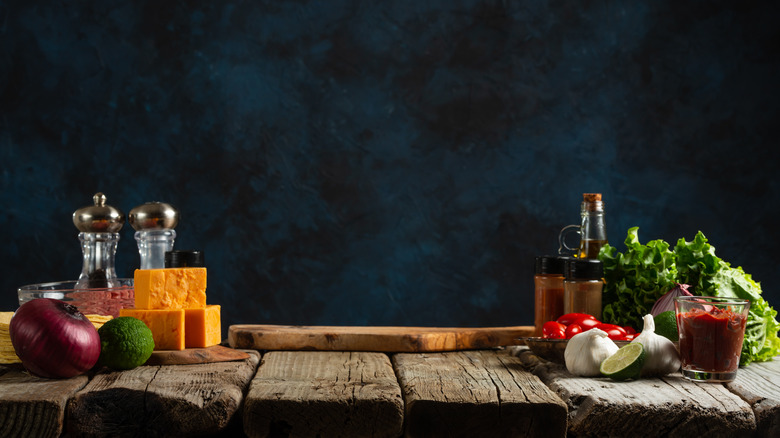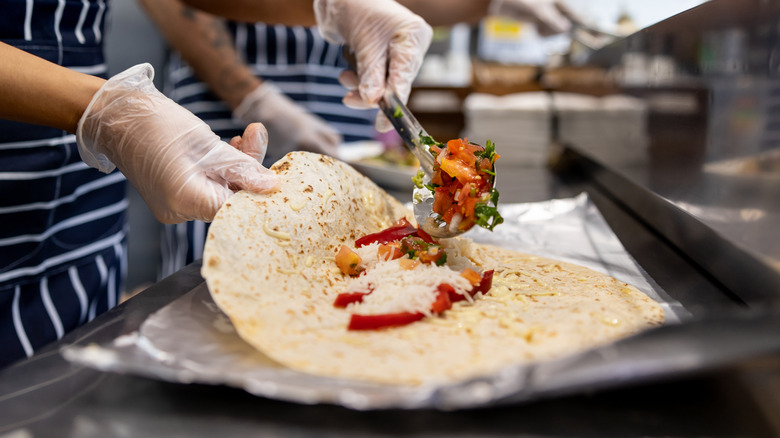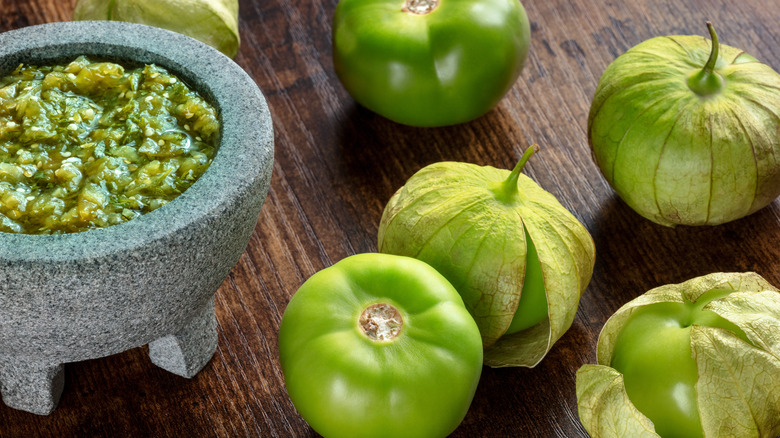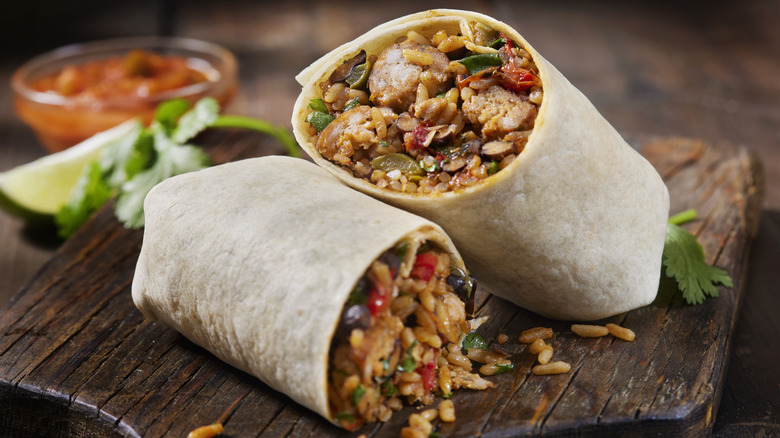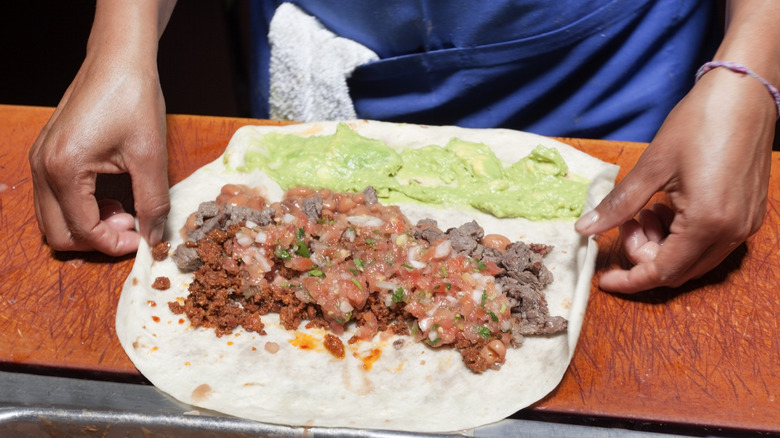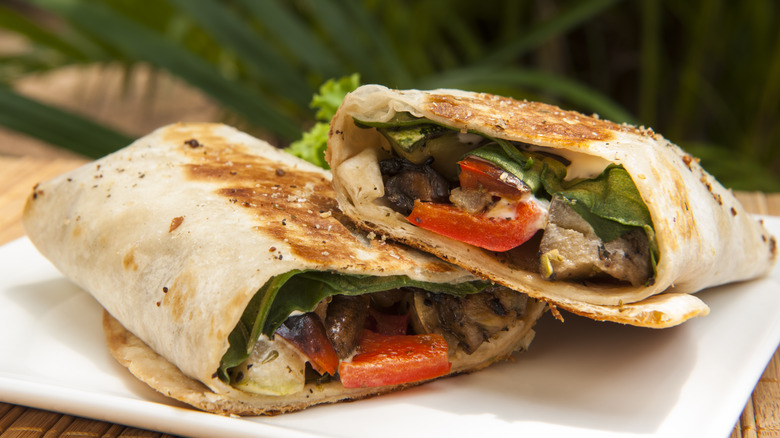The Biggest Mistakes Everyone Makes When Making Burritos
Making burritos might seem like a simple endeavor. You make some fillings and wrap it all up in a tortilla — easy, right? Well, you may soon learn that it's easy to make a mediocre burrito, but it's much harder to make a great one. We understand the joy that comes from a well-made burrito, with its perfect blend of flavors, textures, and aromas all nestled within a warm, inviting tortilla.
So, we're here to help you avoid some of the most common burrito-making pitfalls and craft the best burrito in town. It's time to elevate your burrito game by avoiding these errors that could turn your dinner into a downer, from overstuffing to using low-quality tortillas to not paying attention to the balance of flavors in your burrito. Join us as we dissect the biggest mistakes everyone makes when making burritos, and arm yourself with the knowledge to craft burritos to rival the best in the nation.
Not knowing about different burrito styles
If you think all burritos are largely the same, then that's your first mistake. If you don't explore the big, wide world of burrito styles, then the reality is that you're missing out on some delicious meals. So, before you get started trying to improve your burrito game, take a moment to learn about some of its most popular forms.
First up is the Mission burrito, hailing from the vibrant streets of San Francisco and renowned for its colossal size and robust combination of ingredients. These burritos boast a hearty mix of rice, beans, meat, and an array of condiments, all neatly wrapped in a massive tortilla. The key here is balance, as every bite promises a bit of everything. Meanwhile, a Mexican-style burrito traditionally features a filling of guisado, a thick stew made with ingredients such as meat, beans, vegetables, and spices. This is wrapped in a flour tortilla with no extras, meaning these two seemingly simple components need to be top-notch. And in a Dorado-style burrito, the tortilla is typically grilled or pan-fried until it develops a golden-brown and slightly crispy exterior. This happens after the burrito is filled and just before it's served up to a hungry diner.
These are just three of the many styles of burritos you could try your hand at making, so it's worth the time investment to learn more about the many ways to craft a burrito.
Buying subpar tortillas
Choosing low-quality tortillas for your burrito is akin to building a house on s shaky foundation. If you don't have the right materials to work with, it might all fall to pieces. So, while it may be tempting to grab basic grocery store tortillas for convenience and cost savings, this could be a big mistake. Subpar tortillas lack the texture, flavor, and structural integrity that a premium version brings to the table. Picture a burrito collapsing in your hands because the tortilla couldn't stand up to the task. Who wants that?
Investing in high-quality tortillas is a game-changer. Seek out those that have been crafted with care, perhaps from a local Latino grocer or even by trying your hand at making a homemade version. Some taquerias, Mexican restaurants, or burrito joints will also sell you good tortillas for a reasonable price. Don't settle for mediocrity. Elevate your burrito game by choosing the foundation wisely.
Using cold tortillas
Using cold tortillas for your burrito is a serious culinary misstep that can compromise the entire eating experience. Cold tortillas tend to be stiff, making them prone to cracking and tearing when you try to assemble your burrito. What's more, eating a burrito includes enjoying that soft, pliable, slightly elastic tortilla. A cold tortilla throws the texture of your burrito off, making the whole thing less enjoyable.
Luckily, it's simple to rectify this mistake. Just heat your tortillas before assembling your burrito. First, try microwaving your tortillas. Place a stack of tortillas on a microwave-safe plate, separated by damp paper towels. Heat in 20 to 30-second intervals until warm.
Don't have a microwave? You can also heat each tortilla in a dry, hot skillet for about 10 to 15 seconds per side. Be careful not to overcook, as this can lead to excessive dryness. For an oven-based method, first, preheat your oven to a low temperature (around 300 degrees). Wrap a stack of tortillas in aluminum foil and heat for 5 to 10 minutes. You can also place tortillas in a steamer basket over simmering water for a minute or two until they become pliable.
Using tortillas that are too small
Opting for too-small tortillas when making a burrito is a misstep that can easily lead to frustration and a messy eating experience. The size of the tortilla plays a crucial role. It must accommodates a generous amount of fillings while allowing for proper wrapping without risking tears or overstuffing. If your tortilla is too small, it limits your filling options and can result in a cramped, messy burrito where ingredients spill out with each bite.
Most culinary experts recommend tortillas in the range of 12 to 14 inches for crafting a well-proportioned burrito. This size provides ample space to showcase a diverse array of fillings without sacrificing the integrity of the tortilla. While some may argue that a 10-inch tortilla can suffice, a larger tortilla offers more flexibility and ease of rolling. It all results in a more enjoyable and visually appealing burrito.
In the world of burritos, size really does matter. So, embrace larger tortillas. It'll be easier to roll and you're less likely to end up with an overstuffed burrito that splits and spills its fillings everywhere.
Adding unseasoned rice
The rice in your burrito represents a great but oftentimes forgotten chance to inject flavor. But remember that using unseasoned rice in a burrito can leave you with a bland meal. Well-seasoned rice can complement other ingredients and create a burrito that tastes great.
So, how do you season the rice for a delicious burrito? One option is to replace plain water with a flavorful cooking liquid such as vegetable broth. This simple substitution adds a layer of savory richness to the rice. Citrus zest is another great seasoning for rice. Grate the zest of a lemon, lime, or orange into the rice for a burst of acidic brightness. This adds a refreshing element that pairs well with various burrito fillings. Or, you can add chopped fresh herbs like cilantro to the cooked rice. Likewise, feel free to experiment with spices like cumin, garlic, onion powder, or chili powder, which can add warmth and depth of flavor to the rice.
Combine these seasoning methods based on your taste preferences and the flavor profile of your chosen burrito fillings. Remember that the key here is to elevate the rice from a mere filler to something that tastes amazing in its own right.
Making beans an afterthought
Beans should never be relegated to the shadows in your burrito creation. Done right, black and pinto beans emerge as front-runners. Pintos boast a softer, creamier texture compared to their black counterparts. Either can meld seamlessly with other ingredients when cooked properly. Refried beans, another popular option, bring a velvety consistency and rich, savory flavor that complements many fillings.
While cooking beans from scratch can yield a depth of flavor that's hard to match, the convenience of canned beans is a perfectly acceptable shortcut in many busy kitchens. Canned beans, when rinsed and seasoned well, can save you time without compromising much on taste. So, whether you're a purist who's simmering beans for hours or a busy burrito enthusiast opting for the canned route, let beans shine as a delicious and versatile component in your burrito repertoire. They're not just a sidekick; they have the potential to steal the spotlight.
Using the same fillings every time
We know how tempting it is to stick to tried-and-true burrito fillings. You know you like them, so they're a safe bet. But, if you aren't experimenting with new flavors, you're missing out on the possibility of some wonderfully delicious combinations. Take this as the cue to break free from the monotony and explore a world of tantalizing possibilities, both classic and unconventional, to elevate your burrito experience.
For a classic yet delightful twist, indulge in a combination of seasoned smoked tofu, black beans, cilantro-lime rice, and a zesty pico de gallo. The interplay of savory, smoky, and citrus notes here is a winner. Or you could turn to the hearty duo of sweet potato and black beans, which harmonize especially well with sautéed spinach, avocado slices, and a smoky chipotle sauce. For a vibrant burst of freshness, try a mix of mango salsa, lemon rice, black beans, cheese, and shredded cabbage.
Basically anything can go in a burrito if you're brave enough. What about cheeseburger or Buffalo chicken burritos? You could even stick spaghetti and meatballs in a burrito. Use your imagination and go wild. The worst that can happen is that you come up with a few duds.
Not paying attention to flavors
Crafting a truly remarkable burrito is an art, and a large part of that skill lies in paying close attention to the flavors that go inside. Each element, from the protein to the salsa, should contribute to a beautiful balance of taste.
There are a range of ways to ensure a flavor-packed burrito experience. One is to marinate and season your protein generously. Whether it's chicken, tofu, or even halloumi cheese, infuse your protein choice with a blend of spices and herbs to create a robust foundation for your burrito. You can also incorporate fresh herbs like cilantro or thyme for a pop of brightness. A handful of crisp greens, such as shredded lettuce or spinach, adds a refreshing element and textural contrast.
You should always season your burrito-bound rice and beans liberally as well. Whether you're baking fragrant cilantro lime rice or well-seasoned black beans, they should be as flavorful as the other components of your burrito. Also, consider small yet impactful upgrades. For instance, char your limes before squeezing them into guacamole for a subtle smokiness that elevates the entire dish.
Remember that part of the beauty of burritos is that you can experiment and tailor them to your unique taste preferences. All you have to do is pay attention to flavors and implement simple upgrades to transform your burrito into something special.
Managing timings poorly
Managing your timing effectively can make the difference between a seamless culinary experience and a chaotic kitchen fiasco. Poorly managed burrito-making not only adds stress but can also result in unevenly cooked components or, worse, a cold burrito. To avoid this culinary conundrum, you need to master the art of timing in burrito preparation.
Start by prepping all your ingredients before turning to a heat source. Chop vegetables, marinate proteins, and have your spices and condiments measured and ready to go. This step, often known as mise en place, ensures a smooth flow during the cooking process. Next, identify components that can cook simultaneously. For example, while your protein is grilling, you can use that time to sauté veggies or warm up your tortillas. This multitasking approach minimizes downtime.
Be sure to understand the hierarchy of cooking times for each ingredient. Begin with those that take the longest, such as slow-cooked meats or grains, and work your way through the list to the quicker-cooking elements like sautéed vegetables or toppings. Tortillas should be one of the last components you heat, but if they're ready before some of your fillings, you can keep them warm in a clean kitchen towel or tortilla warmer. Finally, assemble your burritos just before serving to maintain optimal warmth and texture. This prevents the risk of sogginess or a lukewarm meal.
Unevenly distributing ingredients
Distributing ingredients evenly in your burrito is a must. If you've ever been excited for the perfect last bite of burrito, only to find out it contains nothing but sour cream, you'll understand why. Taking a little extra time and attention to ensure even distribution makes it so that each bite contains a balanced combination of flavors and textures.
So, how do you make sure you distribute evenly? One way is to adopt a systematic layering approach when assembling your burrito. Begin with a base layer of rice or beans, followed by protein, vegetables, and toppings. This ensures that each ingredient is spread evenly throughout the burrito. Or, instead of placing all the ingredients in a single line down the center of the tortilla, create pockets or rows along the length. This method helps distribute the fillings more evenly and minimizes the risk of ingredient clumps.
Whatever your method, when adding ingredients, be sure that you spread them across the entire width of the tortilla. This makes is so that every bite captures a variety of flavors and prevents one ingredient from overshadowing the others.
Ignoring sauces
Sauces play a pivotal role in elevating the flavor of burritos, adding moisture, richness, and complexity to each bite. They not only contribute to the overall taste but also enhance the texture. Burritos can sometimes be on the dry side, especially if the fillings include rice or beans. Sauces help every bite be succulent and satisfying.
What's great about sauces is that there are many options, from the classic to the more unexpected. Your choice can also affect the overall experience of tasting the burrito. Pico de gallo is a common choice, with its vibrant combination of diced tomatoes, onions, cilantro, jalapeños, and lime juice that adds a fresh, tangy kick to your burrito.
Then, of course, there's guacamole, with its creamy avocado texture and kick of lime. Lime crema is a similarly zesty and creamy option. Chipotle aioli adds a touch of spice, as it's made with chipotle peppers in adobo sauce that have been blended with mayonnaise to add heat and depth of flavor to your burrito. And don't forget the many other salsas out there, including tart, tomatillo-forward salsa verde as well as sweet, spicy mango habanero salsa.
Using the wrong amount of filling
The art of crafting the perfect burrito extends beyond choosing the right ingredients to the issue of filling proportions. It's a problem to both overfill and underfill burritos, so it's important to get the balance right.
Overloading your burrito with excessive fillings makes it challenging — or occasionally impossible — to roll. You're left with a behemoth that's difficult to handle and eat. This can lead to ingredients spilling out with each bite. Overstuffed burritos are prone to tearing, as the structural integrity of the tortilla is compromised. On the flip side, underfilling your burrito leaves you with a hollow, unsatisfying bite. It doesn't do justice to the potential flavor combinations and textures that a well-crafted burrito promises.
But, how do you get it right? Aim for around 1.5 cups of filling for a 10- to 12-inch tortilla. This is a generous yet manageable amount. Your burrito should roll well without being impossible to manage or disappointingly underfilled.
Rolling incorrectly
Poorly rolled burritos simply don't hold together, leaving you with a literal mess on your hands. Rolling a burrito correctly is a skill that doesn't come naturally to everyone. The good news is that you can learn.
To roll a burrito, first place the warmed tortilla on a clean, flat surface. Ensure the tortilla is pliable and easy to work with, and that all your filling ingredients are ready and easily accessible. When filling, make sure those ingredients are evenly distributed across the surface of the tortilla, and be mindful not to overfill. Leave some space along the edges to facilitate rolling without spillage.
Now comes the rolling part. Take two sides of the tortilla and fold them over the filling. This creates a barrier on each end that will keep the contents from escaping. Start rolling the burrito from the bottom edge (the edge closest to you). Tuck the filling in as you roll, using your fingers to keep the ingredients compact. Once the bottom is tucked over the filling, roll the burrito the rest of the way to form a cylinder.
Not considering toasting as an option
If you aren't considering toasting your burrito after rolling it, you're making a mistake. Yes, it adds time, but toasting adds extra texture and flavor. This optional step takes your burrito from merely wrapped to a warm, crisp delight. Some people love it and some people aren't fans, but it's certainly a step worth considering.
Toasting not only gives you a crispy exterior, but it can intensify the flavors in your burrito. The brief exposure to heat allows the tortilla to develop a subtle char, adding a smoky and toasted note that complements the fillings.
Considering toasting? Well, it's easy. All you need to do is heat a skillet and then gently place the rolled burrito, seam-side down, onto the hot surface. Allow the burrito to toast for 1 to 2 minutes on each side, or until the tortilla becomes golden brown and slightly crispy. Use a spatula to carefully flip the burrito. There's no need for oil, as a dry skillet is all you require.
